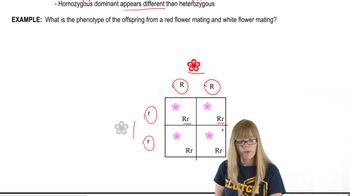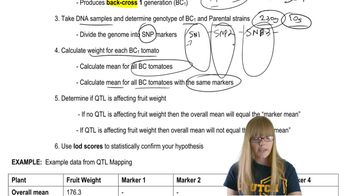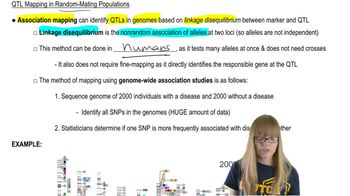Table of contents
- 1. Introduction to Genetics51m
- 2. Mendel's Laws of Inheritance3h 37m
- 3. Extensions to Mendelian Inheritance2h 41m
- 4. Genetic Mapping and Linkage2h 28m
- 5. Genetics of Bacteria and Viruses1h 21m
- 6. Chromosomal Variation1h 48m
- 7. DNA and Chromosome Structure56m
- 8. DNA Replication1h 10m
- 9. Mitosis and Meiosis1h 34m
- 10. Transcription1h 0m
- 11. Translation58m
- 12. Gene Regulation in Prokaryotes1h 19m
- 13. Gene Regulation in Eukaryotes44m
- 14. Genetic Control of Development44m
- 15. Genomes and Genomics1h 50m
- 16. Transposable Elements47m
- 17. Mutation, Repair, and Recombination1h 6m
- 18. Molecular Genetic Tools19m
- 19. Cancer Genetics29m
- 20. Quantitative Genetics1h 26m
- 21. Population Genetics50m
- 22. Evolutionary Genetics29m
20. Quantitative Genetics
QTL Mapping
Problem 23
Textbook Question
Type A1B brachydactyly (short middle phalanges) is a genetically determined trait that maps to the short arm of chromosome 5 in humans. If you classify individuals as either having or not having brachydactyly, the trait appears to follow a single-locus, incompletely dominant pattern of inheritance. However, if one examines the fingers and toes of affected individuals, one sees a range of expression from extremely short to only slightly short. What might cause such variation in the expression of brachydactyly?
 Verified step by step guidance
Verified step by step guidance1
Identify the pattern of inheritance: The problem states that brachydactyly follows an incompletely dominant pattern, meaning that heterozygous individuals will show a phenotype that is intermediate between the two homozygous phenotypes.
Consider the role of modifier genes: These are genes that can influence the expression of a trait, potentially causing variation in the phenotype even when the primary gene is the same.
Examine environmental factors: Environmental influences, such as nutrition or physical activity, can also affect the expression of genetic traits, leading to variability in phenotypic expression.
Explore the concept of penetrance and expressivity: Penetrance refers to the proportion of individuals with a particular genotype that actually displays the phenotype, while expressivity refers to the degree to which a trait is expressed. Variability in these can lead to differences in the severity of brachydactyly.
Consider the possibility of polygenic effects: Although the trait is primarily determined by a single locus, other genes may contribute to the overall phenotype, resulting in a range of expression.
Recommended similar problem, with video answer:
 Verified Solution
Verified SolutionThis video solution was recommended by our tutors as helpful for the problem above
Video duration:
1mPlay a video:
Was this helpful?
Key Concepts
Here are the essential concepts you must grasp in order to answer the question correctly.
Incomplete Dominance
Incomplete dominance is a genetic scenario where neither allele is completely dominant over the other, resulting in a phenotype that is a blend of both traits. In the case of brachydactyly, this means that individuals with one normal allele and one brachydactyly allele may exhibit a phenotype that is intermediate between the two, leading to variability in the expression of the trait.
Recommended video:
Guided course

Variations on Dominance
Phenotypic Variation
Phenotypic variation refers to the observable differences in traits among individuals, which can arise from genetic differences, environmental influences, or a combination of both. In the context of brachydactyly, the range of finger and toe lengths among affected individuals illustrates how genetic factors can interact with other variables to produce diverse phenotypes.
Recommended video:
Guided course

Genomic Variation
Polygenic Inheritance
Polygenic inheritance involves multiple genes contributing to a single trait, leading to a continuous range of phenotypes. Although brachydactyly is described as a single-locus trait, the observed variation in expression may suggest the influence of additional genes or environmental factors, complicating the inheritance pattern and resulting in a spectrum of phenotypic outcomes.
Recommended video:
Guided course

Organelle Inheritance
Related Videos
Related Practice





